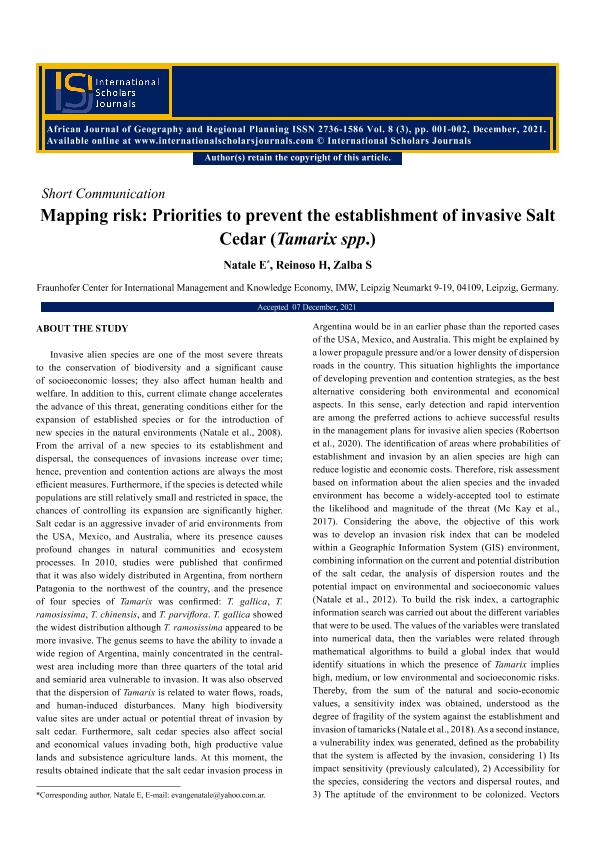Mostrar el registro sencillo del ítem
dc.contributor.author
Natale, Evangelina Sandra

dc.contributor.author
Reinoso, Herminda Elmira

dc.contributor.author
Zalba, Sergio Martín

dc.date.available
2022-10-17T11:13:33Z
dc.date.issued
2022-02-21
dc.identifier.citation
Natale, Evangelina Sandra; Reinoso, Herminda Elmira; Zalba, Sergio Martín; Mapping risk: Priorities to prevent the establishment of invasive Salt Cedar (Tamarix spp.); International Scholars Journals; African Journal of Geography and Regional Planning; 8; 3; 21-2-2022; 1-2
dc.identifier.uri
http://hdl.handle.net/11336/173406
dc.description.abstract
Early detection and rapid intervention are among the preferred actions to achieve successful results in the management plans for invasive alien species. The identification of areas where probabilities of establishment and invasion by an alien species are high can reduce logistic and economic costs. Risk assessment based on information about the alien species and the invaded environment has become a widely-accepted tool to estimate the likelihood and magnitude of the threat. The objective of this work was to develop an invasion risk index that can be modeled within a geographic information system (GIS) environment, combining information on the current and potential distribution of the alien species, the analysis of dispersion routes and the potential impact on environmental and socioeconomic values. The genus Tamarix was used as a case study. This genus is widely distributed in Argentina, from northern Patagonia to the northwest of the country. A risk index was obtained, with potential to be expressed cartographically in a GIS. The relevance of the developed index is that it might be extended and applied to different invasive species, regions and working scales.
dc.format
application/pdf
dc.language.iso
eng
dc.publisher
International Scholars Journals
dc.rights
info:eu-repo/semantics/openAccess
dc.rights.uri
https://creativecommons.org/licenses/by/2.5/ar/
dc.subject
CONSERVACION
dc.subject
BIODIVERSIDAD
dc.subject
RISK ANALYSIS
dc.subject.classification
Conservación de la Biodiversidad

dc.subject.classification
Ciencias Biológicas

dc.subject.classification
CIENCIAS NATURALES Y EXACTAS

dc.title
Mapping risk: Priorities to prevent the establishment of invasive Salt Cedar (Tamarix spp.)
dc.type
info:eu-repo/semantics/article
dc.type
info:ar-repo/semantics/artículo
dc.type
info:eu-repo/semantics/publishedVersion
dc.date.updated
2022-09-21T18:41:40Z
dc.identifier.eissn
2736-1586
dc.journal.volume
8
dc.journal.number
3
dc.journal.pagination
1-2
dc.journal.pais
Nigeria

dc.journal.ciudad
Abuja
dc.description.fil
Fil: Natale, Evangelina Sandra. Universidad Nacional de Rio Cuarto. Facultad de Cs.exactas Fisicoquimicas y Naturales. Instituto de Ciencias de la Tierra, Biodiversidad y Ambiente. - Consejo Nacional de Investigaciones Cientificas y Tecnicas. Centro Cientifico Tecnologico Conicet - Cordoba. Instituto de Ciencias de la Tierra, Biodiversidad y Ambiente.; Argentina
dc.description.fil
Fil: Reinoso, Herminda Elmira. Universidad Nacional de Río Cuarto; Argentina
dc.description.fil
Fil: Zalba, Sergio Martín. Consejo Nacional de Investigaciones Científicas y Técnicas; Argentina. Universidad Nacional del Sur; Argentina
dc.journal.title
African Journal of Geography and Regional Planning
dc.relation.alternativeid
info:eu-repo/semantics/altIdentifier/url/https://www.internationalscholarsjournals.com/articles/mapping-risk-priorities-to-prevent-the-establishment-of-invasive-salt-cedar-tamarix-spp-84818.html
Archivos asociados
